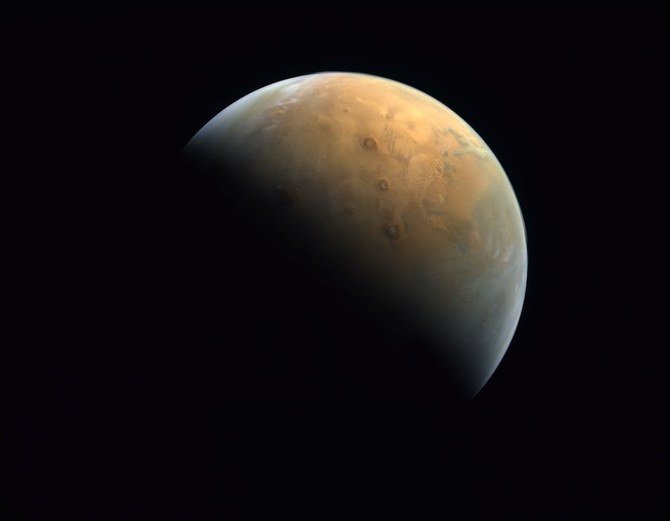
- ARAB NEWS
- 18 Jul 2025

The UAE’s “Hope” probe sent back its first image of Mars, the national space agency said Sunday, days after the spacecraft successfully entered the Red Planet’s orbit.
The picture “captured the largest volcano in the solar system, Olympus Mons, emerging into the early morning sunlight,” it said in a statement.
The image was taken from an altitude of 24,700 kilometers (15,300 miles) above the Martian surface on Wednesday, a day after the probe entered Mars’ orbit, it said in a statement.
Sheikh Mohammed bin Rashid, UAE prime minister and Dubai’s ruler, shared the colored image on Twitter.
“The first picture of Mars captured by the first-ever Arab probe in history,” he wrote.
من ارتفاع ٢٥ ألف كم عن سطح الكوكب الأحمر .. أول صورة للمريخ بأول مسبار عربي في التاريخ
— HH Sheikh Mohammed (@HHShkMohd) February 14, 2021
The first picture of Mars captured by the first-ever Arab probe in history, 25,000 km above the Red Planet's surface pic.twitter.com/Qgh2Cn3JPF
Hope became the first of three spacecraft to arrive at the Red Planet this month after China and the US also launched missions in July, taking advantage of a period when the Earth and Mars are nearest.
This entry was the very first arrival of a probe from the Middle East to Mars, that was carried on the Japan-made Mitsubishi H2A rocket launched from Tanegashima Space Center in Kagoshima Prefecture in July last year.
Throughout, Japan has played an important role in ensuring the mission’s success and the spacecraft is Japan’s flagship launch vehicle and is one of the most reliable launch vehicles in the world.
The Emirates Mars Mission, which has cost around $200 million, launched the Hope Probe from a Japanese space centre.
The mission is designed to reveal the secrets of Martian weather, but the UAE also wants it to serve as an inspiration for the region’s youth.
The UAE’s venture is also timed to mark the 50th anniversary of the unification of the nation’s seven emirates.
“Hope” will orbit the Red Planet for at least one Martian year, or 687 days, using three scientific instruments to monitor the Martian atmosphere.
It is expected to begin transmitting more information back to Earth in September 2021, with the data available for scientists around the world to study.
إرسال أول صورة للمريخ بعدسة "مسبار الأمل ".. بشرى خير، وفرحة جديدة.. ولحظة فارقة في تاريخنا، تدشن انضمام الإمارات إلى نخبة دول العالم المتقدمة في استكشاف الفضاء.. إن شاء الله تسهم هذه المهمة في فتح آفاق جديدة في عملية اكتشاف الكوكب الأحمر تعود بالخير على البشرية والعلم والمستقبل. pic.twitter.com/Gr24bgel0q
— محمد بن زايد (@MohamedBinZayed) February 14, 2021